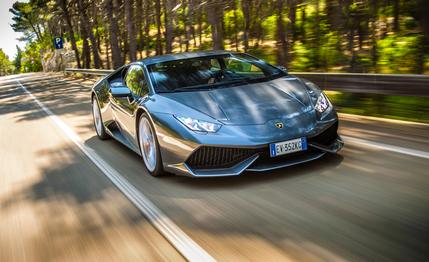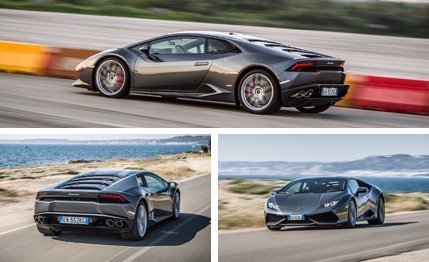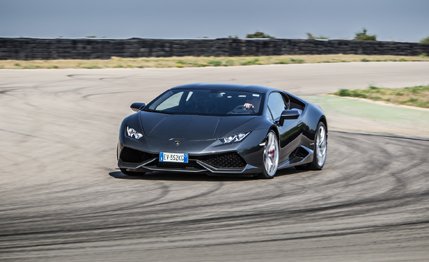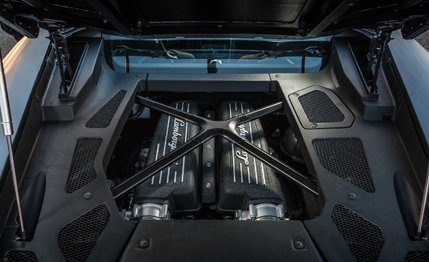
 Instrumented Test
Instrumented Test
You may know the Nardò Ring as the 7.8-mile asphalt track where the world’s automakers take their top-speed vacations. A traffic-free circular autobahn in the heel of Italy’s boot, the Porsche-owned test track is banked such that you can take your hands off any car’s steering wheel at 149 mph in the outer lane. It’s one of the few places on the planet where Lamborghini’s new 10-cylinder wedge, the Huracán, could prove to us how aerodynamically sound it is approaching its claimed top speed of 202 mph.
We say “could” because the ring is off-limits today. Instead, we’re rifling through Nardò’s other treasure, a 3.9-mile squiggle of asphalt known only as the handling track. Wide enough to field a NASCAR race and technical enough for a Grand Prix, it merits a more pretentious name, so we’ll give it one.


Circuito Internationale Nardò, as we’ll call it, is 16 corners of sweepers, hairpins, and flyers that make it a perfect place to inspect Lamborghini’s new runt and its 602-hp, anything-but-runty V-10. Halfway around the track, you crest a small rise that reveals a heart-stopping panorama stretching to the horizon. The land falls all the way to the Ionian Sea, creating the illusion that a wrong move could send the Huracán sliding nearly two miles into the drink.
A car with this much drama and this much speed doesn’t let your pulse rest for long. The Huracán corners flat, grips doggedly, and blitzes out of bends. But it keeps your heart rate from fully redlining by being just as precise and predictable as it is explosive. There’s more understeer in this four-wheel-drive Huracán than elsewhere in the mid-engine stratum, but it’s hardly the frightening push of some past Lambos. Trail the brakes or lift in a corner and the aluminum-and-carbon-fiber space frame willingly changes direction. The brakes bite progressively, with some of the best modulation we’ve experienced from carbon-ceramic discs. Pirelli P Zero rubber sinks claws into the pavement to produce cornering grip of 1.01 g’s and a 70-to-0-mph stopping distance of just 144 feet. The seven-speed dual-clutch automatic, Lamborghini’s first such transmission, executes ruthless, premeditated gearchanges. You don’t miss turbochargers when you have 10 cylinders inflating a torque curve to such a healthy level, either.

 According to our tests, the baby Lambo is quicker than not just the Ferrari 458 Italia but also its big brother, Lambo's Aventador.
According to our tests, the baby Lambo is quicker than not just the Ferrari 458 Italia but also its big brother, Lambo's Aventador.
Lamborghinis once had a reputation for being fast in a straight line and clunky in corners. This car is fast everywhere, though our test gear confirmed that this Huracán is freakishly quick in a straight line. We ripped to 60 mph in 2.5 seconds and burst through the quarter-mile in 10.4 seconds at 135 mph. Forget the comparable Ferraris and McLarens—they’re eating the Huracán’s dust. In fact, the little Lambo even knocks off the Porsche 911 Turbo S, a computerized acceleration kill-bot and another bright satellite in the VW universe. This thing is Veyron quick.
But the real drama lies closer to home as the Huracán, base price of $241,945, beats the $404,195 Lamborghini Aventador in the critical acceleration measures by a half-second. You still have to buy the expensive one, however, if you want doors that open up rather than out. Seems worth it, no?


Our Huracán demands a break after 55 miles of Nardò’s handling track. The water-temperature needle nips at the red, and the digital instrument cluster begs us to have mercy on the transmission. When a cool-down lap yields no relief, we pit. The 5.2-liter decachord behind the seats snorts steam through its air intakes and the slatted engine cover, enveloping the rear half of the car in a sweet-smelling ethylene-glycol fog.
The popular story line holds that the newest bulls mark a monumental shift for Lamborghini and its relationship with Audi; that the Germans have gone down to where the wild things are and tamed one and made it their own. The blown coolant hose is only the first indication that this Lamborghini is still very much Italian.